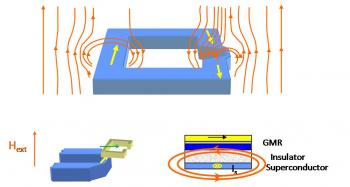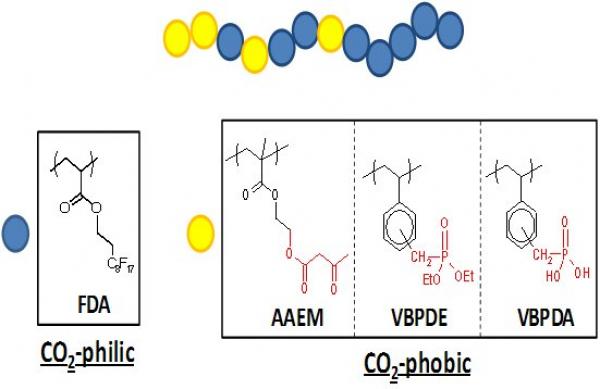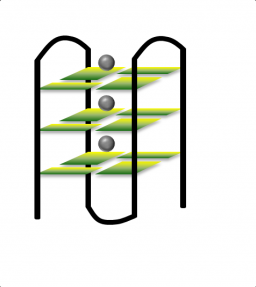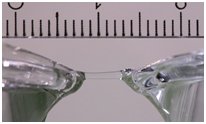2010
BiFeO3 is a multiferroic materials in which ferroelectric and anti-ferromagnetic orders coexist well above room temperature (TN=643 K, TC=1093 K), with a high polarization (over 100 μC/cm2 [1]). We have shown at the LLB by neutron diffraction that these two order parameters interact and that the magnetization of the material can be modified by the application of an electric field. This opens the way towards the implementation of this material in spintronic devices in which magnetization could be controlled by a small electrical voltage rather than by currents or magnetic fields.
Although magnetoelectric materials have been known for decades, no direct proof of the coupling between the two co-existing physical effects had been reported in the literature. We have demonstrated this magneto-electric coupling by neutron diffraction on BiFeO3 single crystals. One key to success was the exceptional quality of the high purity single crystals which are magnetically and electrically single domain. More...
Measurements of very weak field (down to the femtotesla range) have been mainly addressed by low-Tc SQUIDS. We have proposed in 2004 the principle of a new sensor, based on spin-electronics, to offer extremely good sensitivity for measurements of magnetic fields over a wide range of frequency (dc to hundreds of MHz).
These sensors, called mixed sensors, are based on the association of a sensitive field sensor (Giant Magnetoresistance or Tunnel Magnetoresistance) and of an efficient flux-to-field transformer. The transformer is a cm size superconducting loop containg a micron size constriction. When an external field is applied perpendicular to the loop, a supercurrent is generated, to prevent the entrance of the field in the loop. This supercurrent reaches a very high density when passing through the constriction. The stray field lines due to this current can be locally hundreds to thousands times larger than the applied field. If one locates a GMR or TMR element on top or below the constriction, it will collect this locally enhanced field lines and a change in the resistance of the GMR (TMR) element can be measured (see Figure 1).
This device is fully made out of thin film technology, and can be either using a low-Tc (typically Nb) loop or a High-Tc (YBaCuO) loop. In the first case, liquid helium cooling is required whereas in the second one only nitrogen cooling is necessary.
Guanine rich DNA strands, as those encountered at the extremities of human chromosomes, have the ability to form four-stranded structures (G-quadruplexes) whose building blocks are guanine tetrads. G-quadruplex structures are intensively studied in respect to their biological role, as targets for anticancer therapy and, more recently, to their potential applications in the field of molecular electronics.
We have shown that self-association of guanines gives rise to exciton states. As a consequence, ultrafast excitation transfer takes place within G-quadruplexes. Self-association of guanines slows down the fluorescence decays and increases the fluorescence quantum yield. The relaxation of ππ* states toward lower energy charge transfer excited states, involving guanines on different tetrads, depends on the nature cations in the central cavity; it is facilitated by Na+ ions, which are smaller and more mobile compared to K+ ions.
The characterization of the primary events that are induced by absorption of UV radiation by DNA is important in two respects. On the one hand, it sheds light on the fundamental processes involved in the UV-induced damage to the genetic code. On the other hand, the determination of the factors that govern the DNA optical properties may contribute to the design of DNA-inspired materials for optoelectronics.
In this context, we study various DNA systems in solution:
► monomeric chromophores: bases, nucleosides, nucleotides
In 1893 Sir William Armstrong reported a remarkable experiment: if a high voltage is established between two wine-glasses filled to the brim with pure water and connected by a cotton thread, a rope of water is formed and remains suspended between the lips of the two glasses. This "water bridge" can subsist for a few seconds even once the thread has been removed [1].
Recently, a group of physicists from Graz University, Austria [2] succeeded on establishing a bridge (without any thread!) between the two glasses under a voltage of 20 kV. The length of the bridge may reach values larger than 1 cm, its diameter is of the order of a few mm and the lifetime currently exceeds 1 hour. Under the effect of the electrical field, the local temperature increases and reaches 60° C, a temperature sufficient to break the bridge. More...
Voir aussi le fait marquant :
- Des neutrons pour étudier la structure de l'eau : le pont d'eau lourde
/ See also the IRAMIS highlight:
- Neutrons to investigate the structure of water : the heavy water bridge
Using conjugated polymers as the active materials in electronic and optoelectronic devices opens up the possibility of fabricating all-polymer devices using solution processing technologies. The fabrication of good quality field-effect transistors (FETs) is crucial to a number of polymer-based devices, such as active matrix displays and integrated circuits. Central to FET operation is the dielectric/semiconductor interface. Here we look at the interface between a polymer gate dielectric and a conjugated polymer, using neutron reflectivity. By using a mixed solvent (toluene/cyclohexane) to deposit the conjugated polymer directly on top of the polymer dielectric we are able to fabricate bilayer FET architectures with systematically controlled interfacial roughness, and study the impact on transistor performance. More...














 G-quadruplex publications.pdf
G-quadruplex publications.pdf



